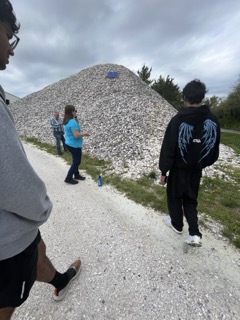Event name: Field Trip: Horn Point Laboratory & Blackwater National Wildlife Refuge
Event time and place: April 20th, 2024, University of Maryland Center for Environmental Research, Cambridge, MD

Picture of Oyster Spawn ready to be placed into the Chesapeake Bay
The first conservation/environmental issue that the Horn Point Laboratory is dealing with is restoring the Chesapeake Bay and conducting its own research on this area. The Chesapeake Bay is one the most important bodies of water for the Eastern Shore as it provides economic benefits and is home to countless organisms. The Chesapeake Bay is one the largest estuaries which means that it encompasses various organisms that wouldn't normally coexist. It is also a very productive fishery for the East Coast. Over the last century, the water levels have continued to rise in the Chesapeake Bay as a result of climate change. This effect can be seen not only in the Chesapeake Bay but globally as well. Another effect that has been noticed in the Chesapeake Bay is the differences in salinity. As discussed with our tour guides, there is a wide range of salinity levels in the Chesapeake Bay which make it an estuary. One thing that they are studying with this is the effect of the increased rainfall on salinity levels in certain areas of the bay and how this affects the organisms that would normally live there. Another tool that the scientists at Horn Point used for this was the Striper which is the name of their Storm Glider. This tool is helpful for them in their combat against climate change because of its ability to track water temperatures at different depths and report back data to them. This allows scientists to predict hurricanes and other natural disasters in the oceans. Another tool that is similar to this is the Bay NOOA Chesapeake Interpretive Buoy System (CBIBS) which is Another way that they have combatted these effects is through the creation of man-made islands in the form of Tidal Wetlands. Poplar Island is a small stretch of land in the Chesapeake Bay that provides habitat for wildlife species such as aquatic organisms (fish and crabs), small mammals (muskrats), and birds both migratory and resident.
The second conservation/environmental issue that the Horn Point Laboratory is dealing with is the decline in the population of oysters in the Chesapeake Bay. As discussed with the tour guides, oysters are a vital part of the Chesapeake Bay ecosystem as they provide filtration of excess nutrients such as nitrogen from the water. They also provide homes for organisms and are a food source which helps the economy of this area. Furthermore, Oyster populations are monitored by the Horn Point Lab by using surveys of the area. The biggest contribution that the Horn Point Lab has made towards restoring the Chesapeake Bay is through their Oyster Restoration Hatchery. This is an in-depth process in which the scientists at the Horn Point Lab have been able to spawn oysters and have deployed over 1 billion oysters spat into the waters of the Chesapeake Bay over the past decade.
Both the Horn Point Laboratory & the Blackwater National Wildlife Refugee work to reach the community at large. The Horn Point Laboratory reaches out to the community at large through educational activities. This includes the tours, i.e. the oyster hatchery tour as well as other activities like shell bagging and oyster cage building which adhere to various age groups. The Blackwater National Refugee reaches out to the community at large through services for the public which include self-guided tours and educational drives that allow the community to view the scenery.



